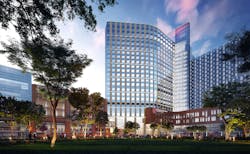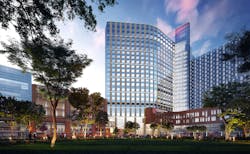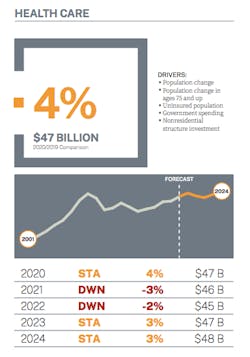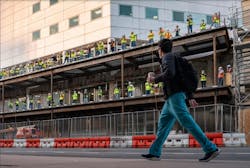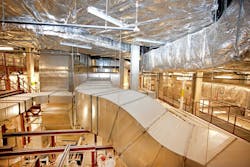As hard as the Coronavirus pandemic has hammered U.S. design and construction activity over the last year, the U.S. healthcare market not surprisingly has been one of the few silver linings for our industry. After all, even if more workers and students choose not to return to offices and schools in the near future, medical patients will not have the choice to hospitalize themselves at home.
So, hospital and clinic construction has managed to keep its head above water throughout this chaotic past year, even as elective surgeries plummeted and telemedicine expanded exponentially to accomodate remote doctor visits. And most industry forecasters now expect U.S. healthcare work to grow slightly throughout the rest of this year, before gaining some genuine momentum in 2022.
According to the latest AIA Consensus Construction Forecast for 2021, released in December, the $47-billion U.S. healthcare construction market is one of only two nonresidential markets predicted to grow at least 1% this year. (The other is for public safety work.) Crunching numbers from the American Institute of Architects and eight other economists, the consensus forecast calls for 3.2% growth in 2022.
- To view the interactive AIA chart, click here.
Among the individual forecasters, Dodge Data & Analytics is the most bullish for next year, predicting 8.4% growth in healthcare projects, after a 2% climb this year. Of course, the success so far of the national COVID-19 vaccine rollout could even lead to better numbers.
“Hope is building for a strong economic recovery fueled by the growing number of vaccinated Americans,“ said Dodge Data Chief Economist Richard Branch on March 16. “But the construction sector will be hard-pressed to take advantage of this resurgence as rapidly escalating materials prices and a supply overhang across many building sectors weighs on starts through the first half of the year.”
Associated Builders & Contractors (ABC) Chief Economist Anirban Basu also is very concerned about inflation, but notes that hope, itself, might be accelerating a comeback. "The expectation that rapid economic recovery could begin later this year has now swept through the nonresidential construction sector, which is surprising, as I anticipated this segment would be less upbeat,” said Basu on March 9. Despite headwinds, contractors now expect sales, staffing levels and profit margins to expand over the next six months, he added.
“The way to reconcile downbeat macroeconomic considerations with growing contractor confidence is to analyze backlog," Basu explained. "Backlog has been edging higher for several months and rose sharply last month as projects that had been mothballed are coming back to life."
Specifically re healthcare projects, as part of the AIA Consensus Forecast, ABC already is predicting a robust 6.7% bump in 2022, after a strong 4.0% rise in 2021.
Of note, Dodge Data reports that the largest nonresidential building project to break ground in February was the $1.7-billion Wexner Inpatient Hospital Tower at the Ohio State University Medical Center in Columbus OH. The massive, five-year project is being built by a joint venture of Walsh/Turner Construction, and designed by architect-engineer HDR Inc.
On its website, HDR posted this observation last month under the title, Beyond Pandemic: Air Quality:
Biosafety and biocontainment have been brought to the forefront since the arrival of COVID-19. Patients and staff alike are concerned with the safety of their built environments. Access to and proper use of personal protective equipment (PPE) are the primary concerns, and work in tandem with strategies to ensure that mechanical systems meet biosafety and biocontainment best practices not just for the foreseeable future — but for the long-term as well. That means these systems must represent economically viable solutions.
SHORT-TERM GAINS, LASTING CHANGES
In his own 2021 forecast for the Plumbing Heating Cooling Contractors Association, published Feb. 17, economist Bernard Markstein, who also participates in AIA's consensus report, added:
COVID-19 further raised the already high priority of infection control for healthcare facilities. The requirements for safely treating the coronavirus and the vicissitudes of patient loads have placed a focus on the advantage of adaptable space that can easily and rapidly be reconfigured.
Ventilation is key, with filters that capture extremely high percentages of pathogens and can be easily monitored and cleaned or replaced to keep these systems at peak performance. Designing flexible spaces so that ICUs can be expanded and contracted is another high priority. This includes the ability to create negative air pressure in these units. Touchless plumbing fixtures are also essential. These features are most easily included in new facilities, but there is a great need to incorporate them in existing facilities.
For those reasons, Markstein Advisors is actually the most optimistic of the AIA forecasters for 2021. The firm predicted 8.4% growth this year, and 5.9% in 2022.
Less upbeat is FMI Corp., which is expecting the healthcare market to slide 3% this year, and another 2% in 2022. According to its First Quarter Report for 2021:
Recent awareness of capacity limitations will bolster demand for health care investment through the forecast period. Anticipate future hospital and outpatient facility design to allow for easier capacity flexibility and expansion alongside more commonplace modular construction practices. Industrywide, facility owners will be encouraged to permanently increase cleanliness standards, utilizing no-touch automation, automated cleaning systems and improved air handling.
Even so, the FMI analysts believe that some of the operational changes and tech innovations forced by the pandemic may actually preclude the need for certain healthcare construction in the future.
(We) anticipate accelerated competition in wearable health care technologies. The devices and associated services will encourage and further promote adoption in telehealth, virtual care, and remote medicine. These same technologies and associated services will however limit demand for traditional health care construction needs.
##########
It remains to be seen, of course, how that will all play out down the road. For the moment, larger health facilities that ramped up safety and re-purposed patient space last fall are implementing lessons learned
At the University of Virginia Medical Center in Charlottesville, VA, construction manager Skanska reports that last year it was able to redesign and accelerate portions of an ongoing, $394-million expansion project to meet increased demand for bed capacity brought on by the pandemic. (The picture below graced the May 2020 cover of HPAC Engineering.)At another hospital project under construction in North Carolina's Research Triangle region, Skanska was able to accelerate the turnover of patient floors for emergency use while simultaneously finishing construction on the other floors. The firm worked with its subcontractors and the local building authorities to turn over the two floors a year early. The subcontractors delivered critical services out of their usual sequence, such as domestic water, air handling and fire protection systems, and city building and fire officials streamlined and fast-tracked permitting, according to a blog publishd by the contractor.
##########
LESSONS LEARNED
Last fall, St. Louis-based contractor McCarthy, one of the nation's busiest healthcare builders, surveyed many of the largest U.S. healthcare systems, MEP trade partners, and engineering firms about trends and market prospects. One hospital executive responded, “Flexibility is going to be the name of the game in healthcare.”
Overwhelmingly, survey respondents reported implementing simple, easily integrated solutions to help mitigate the risk of infection. Because COVID-19 can be transmitted by small airborne droplets, improving HVAC systems are top-of-mind, McCarthy found. Strategies include:
- Modifying or augmenting existing air filtration systems;
- Systems that allow for temporary isolation of supply and return air (portable or permanent);
- UV or thermal sterilization techniques.
Equally important is preventing contact transmission. Many healthcare providers are using touchless screening platforms to allow employees to self-assess before entering facilities. Providers also noted a surge in touchless device retrofits for high-risk areas such as doors, elevators and bathroom fixtures. In addition, healthcare providers are using antimicrobial coatings in and around patient areas. McCarthy anticipates these simple, cost-effective preventative measures will become staples of future healthcare facilities.
##########
For more Members Only Market Focus stories, please click here.
About the Author
Rob McManamy
Editor in Chief
An industry reporter and editor since 1987, McManamy joined HPAC Engineering in September 2017, after three years with BuiltWorlds.com, a Chicago-based media startup focused on tech innovation in the built environment. He has been covering design and construction issues for more than 30 years, having started at Engineering News-Record (ENR) in New York, before becoming its Midwest Bureau Chief in 1990. In 1998, McManamy was named Editor-in-Chief of Design-Build magazine, where he served for four years. He subsequently worked as an editor and freelance writer for Building Design + Construction and Public Works magazines.
A native of Bronx, NY, he is a graduate of both the University of Virginia, and The John Marshall Law School in Chicago.
Contact him at [email protected].
